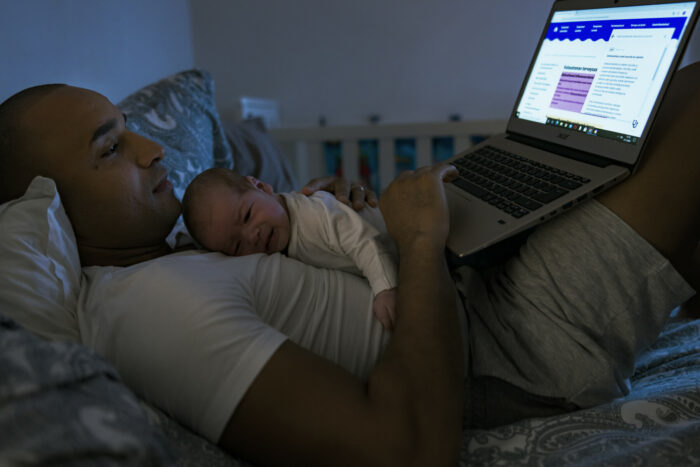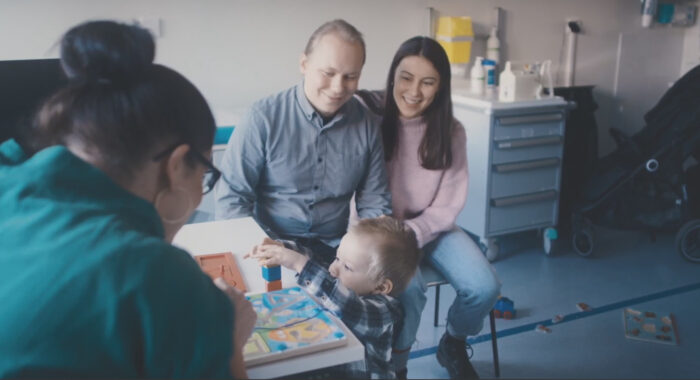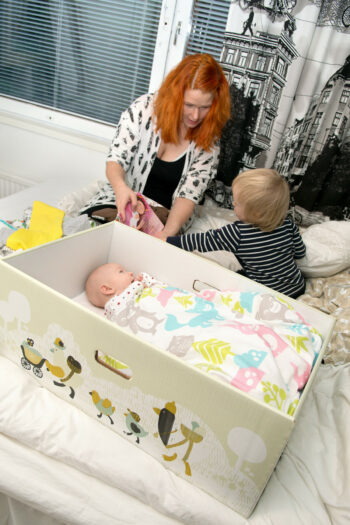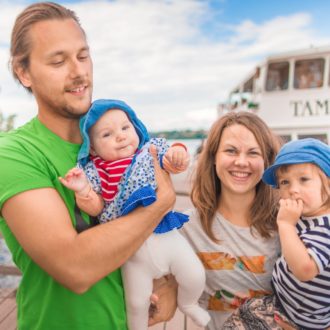The Finnish name for the clinics, neuvola, means “place of advice,” and, as it suggests, the system offers healthcare consultations and services. Since they’re free of charge, they’re readily available to all families, regardless of socioeconomic factors.
There are frequent checkups during the pregnancy, and after the baby is born, the family continues to attend regular appointments for several years. The healthcare staff monitors the infant’s growth and development, as well as fielding any questions the parents may have as they adjust to life as a family.
The first maternity and child health clinic opened in 1922 in the working-class Helsinki neighbourhood of Kallio. In only three years, child mortality rates in that area decreased from 15 to 3 percent.
A healthy start

In 1954, mothers arrive with their babies for appointments at a maternal and child health clinic in Helsinki.Photo: Helsinki City Museum/cc by 4.0
The neuvola system expanded after the Second World War and became part of universal healthcare in Finland. The expansion resulted from a requirement, adopted in 1944, that tasked municipalities with the responsibility of operating their own maternity and child health clinics.
The consequences are visible in the infant mortality statistics: From 1935 to 1944, the national level averaged 67.2 per 1,000 live births. In 1955 the figure was 29.7, then 17.6 in 1965. It continued to drop, hitting 9.6 in 1975. At 1.8 for the year 2021, Finland’s infant mortality statistics are among the lowest in the world.
The maternity and child health clinics are considered a social innovation, a solution that meets social needs and strengthens society. In effect, the clinics improve the nation’s overall health by focusing on its children.
By supplying the whole family with comprehensive support, including healthcare and practical advice, the neuvola helps give all kids of all backgrounds a healthy start in life.
Thinking inside the box
Finland’s Maternity Package (a tradition since 1938): This Finnish invention includes dozens of items for the new baby. Watch our video collage to see how the contents and fabric patterns have changed over the past three decades.Photos: Social Insurance Institute of Finland; Video: Juho Hakuni/ThisisFINLAND.fi
Another, related Finnish social innovation – and also one that is quite social-media friendly, as it happens – is the maternity package, which some people whimsically call a “baby box.”
It contains dozens of supplies for the baby, including clothing, hygiene items and bedding. The parents of about 30,000 newborns elect to receive it each year. Alternatively, they can choose to get a payment (170 euros at the time of writing); almost all first-time parents select the maternity package.
Introduced in Finland in 1938, the concept of the maternity package has been implemented in some form in Ireland, Scotland and Australia, and about 60 other countries. “We have seen various applications and adaptations,” says Tuovi Hakulinen, who is an adjunct professor of health promotion and is also a former research manager at the Finnish Institute for Health and Welfare.
A definite success
Raija unboxes her new maternity package, displays the contents and offers some words of explanation.Video: @Raija7208
Perhaps unsurprisingly, the maternity package has proved to be the perfect subject for unboxing videos. People also post comments about the fabric patterns when new ones appear (each year is different), although the maternity package’s main purpose is function rather than fashion.
Maternity and child health clinics have come a long way since they were born, in 1922. “The Finnish neuvola is undeniably a success story,” says Hakulinen. “Because of it, we brought down maternal and infant mortality rates, and Finland is one of the safest countries for births” – whether you are giving birth or being born.
The clinics assist people with prenatal care, family planning, child development and family health. A host of services are offered around Finland, including prenatal physiotherapy sessions, family counselling, breastfeeding support groups and standard childhood vaccinations. The clinics are tremendously popular; 99.7% of pregnant people in Finland use their services.
Reaching all families

The City of Helsinki offers an online neuvola chat service where parents can talk with healthcare providers in real time. There’s also a 24-hour neuvola chatbot.Photo: Jussi Hellsten/City of Helsinki
Hakulinen, whose decades-long career has included many years working in maternal and child health clinics and in school healthcare centres, says she has seen “how neuvola services have changed and developed,” over the years. “The emphasis on the family as a whole has continuously increased.”
She continues, “A great strength of the Finnish neuvola system is that the services reach practically all families, regardless of socioeconomic situation. We have high-quality services, and people really want to make use of them.”
In recent years, online neuvola services have also expanded. The City of Helsinki offers a neuvola chat service where parents can talk with healthcare providers in real time. There’s also a 24-hour neuvola chatbot that can answer many questions, and a good old-fashioned FAQ page, which is available in English.
The Finnish clinics have served as a source of inspiration in many other countries, which have flexibly adapted the neuvola to fit their own contexts and needs. Japan developed similar holistic healthcare centres for mothers and children based on the Finnish concept, launching them in 2017.
Being heard

One goal of the maternal and child health clinics is to build a safe and healthy family environment.Photo: ThisisFINLAND
With new situations come new challenges for the neuvola system. Kirsi Peltonen, senior researcher at the University of Turku’s INVEST Research Flagship Centre in southwestern Finland, tells us about how maternity and child health clinics play a role in handling extraordinary circumstances.
Every family is different, and families may present the clinics with multiple different challenges. “Together we can build a safe and healthy family environment,” says Peltonen. One example that she has studied is refugee families who are trying to adapt to life in a new country.
“You have to remember that with any families, including refugee families, there are some that are doing well and some that aren’t,” she says. “It’s important to take stock of the situation, both from the parents’ viewpoint and the children’s perspective.”
The neuvola functions as a space to support the physical and mental wellbeing of all families. Children and their families receive support in cases of issues related to trauma or stress. This means communication between practitioners and families, building a safe and calm environment, and helping parents feel that they are being heard and have agency.
A genuine meeting

The box from the maternity package is designed so that it can serve as a first crib.Photo: Annika Söderblom/Social Insurance Institute of Finland
The regularly scheduled visits during the child’s early years also offer a natural opportunity to ask the parents “about their experiences and the effect of those experiences on their current wellbeing,” says Peltonen. The family is already in the office, talking about their child and their day-to-day routine.
The services at maternity and child health clinics have grown and developed over the past century, and adapting them to current global challenges ensures that the system will continue to benefit society.
By the same token, Hakulinen says that with families more diverse than ever before in many different respects, neuvola visits have to include time for a “genuine meeting” and conversation.
Maternity and child health clinics aim to:
- promote the health and wellbeing of pregnant people and their families
- reduce health inequalities in society
- monitor and support healthy pregnancy and the growth and development of children
- identify any need for special support as early as possible
- provide support and assistance when needed
By Emma De Carvalho, December 2022







